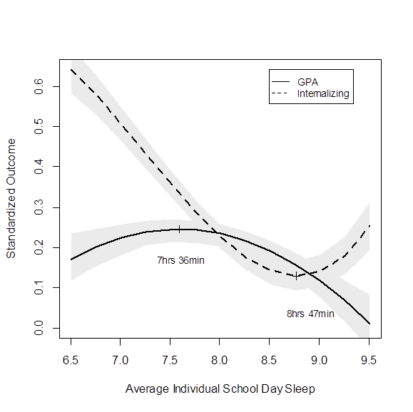How Much Should Teenagers Sleep?
Sleep is associated with virtually every aspect of adolescent adjustment. Public health agencies strive to provide guidelines for the recommended sleep durations for healthy adolescent development. Given that both low and high sleep durations have been linked with compromised functioning (e.g., lower school performance and higher depression), commentators have called for studies of “optimal” sleep in order to determine the amount of sleep at which peak functioning is observed.
 Optimum Sleep for GPA and Internalizing
Optimum Sleep for GPA and Internalizing
Tradeoffs in Optimal Sleep
Efforts to develop sleep guidelines need to consider the possibility that there are tradeoffs of differing amounts of sleep duration for different aspects of development. In a paper published in Child Development, we reported that the amount of sleep associated with the lowest levels of internalizing and externalizing symptoms for Mexican American high school students was more than one hour greater than the amount associated with the highest levels of academic performance. We also observed greater daily variability in sleep duration predicted greater symptomatology and mixed academic outcomes. Our findings suggest that reductions in sleep for the sake of incremental gains in academic performance could have negative implications for mental health. Additionally, promoting healthy sleep behaviors for the sake of improved mental health should include efforts to minimize the variation in adolescents’ sleep duration across their daily life.
Reductions in sleep for the sake of incremental gains in academic performance could have negative implications for mental health
 Age Differences in Optimal Sleep for Daily Mood
Age Differences in Optimal Sleep for Daily Mood
Individual Differences
Sleep recommendations often run into questions of whether there are individual differences in how much sleep adolescents need for optimal health and functioning. In a second paper that appeared in Journal of Clinical Child and Adolescent Psychology, we showed that the sleep needs of teens for their optimal daily mood can differ across individuals. Nevertheless, there were virtually none who were at their best daily mood with less than 7 hours or more than 11 hours – most fell within the commonly-promoted range of 8-10 hours. In addition, younger adolescents and those who report clinically-significant levels of anxiety and or depression symptoms may need extra hours of sleep to reach peak functioning during the day.
There were virtually none who were at their best daily mood with less than 7 hours or more than 11 hours
Next Steps
No single study such as ours should be interpreted as being the definitive source for obtaining an exact amount of optimal sleep for adolescents. Continued research across multiple aspects of adjustment, ages, and populations are necessary before strong conclusions can be made. We suspect that the collective evidence will be consistent with the emergent trend of recommending ranges of sleep durations rather than exact targets (e.g., National Sleep Foundation, National Academy of Pediatrics). Such empirically-based ranges could allow adolescents and their families to set goals that fit their daily lives and maximize their functioning across multiple facets of health and adjustment.
